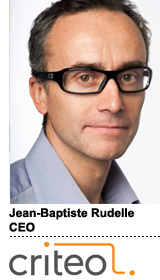 Criteo, the French online display retargeter turned performance marketing company, saw its Q1 revenue increase 68% YoY to €105 million ex-TAC, driven by the growth of its cross-screen tools and client retention “consistently north of 90%.”
Criteo, the French online display retargeter turned performance marketing company, saw its Q1 revenue increase 68% YoY to €105 million ex-TAC, driven by the growth of its cross-screen tools and client retention “consistently north of 90%.”
It added 640 new clients in Q1, giving it a total of 7,800.
Additionally, market conditions have been favorable for Criteo. CEO Jean-Baptiste “JB” Rudelle noted Twitter’s acquisition of retail-centric ad platform TellApart last week. Similarly, Facebook snapped up personalized shopping search engine TheFind in March to add more commerce insights to ads.
“Over the last two years, we’ve seen a general consolidation of a lot of our competitors in the US and Europe, one getting acquired after another,” he said. “This is typical when a market is maturing and you have a very strong leader showing a lot of momentum. It’s getting harder for other players. … Smaller competitors tend to be acquired at some point, which creates more momentum for the [incumbent].”
Rudelle said Criteo’s cash balance of €294 million will precipitate “smart acquisitions,” which the company is being very methodical about. It acquired last quarter retail platform DataPop, a data-driven tool that augments product and pricing information into online ads.
Criteo also intends to build out a “product graph” that details insights about how related items can impact sales volume or campaign performance.
“Anything that increases performance matters,” Rudelle told AdExchanger. “When we’re looking at every element of the value chain, we wanted to make sure each element is fully maximizing our return. We realized that depending on how you structure your data, particularly when you have a large catalog of [retail] products, has a very big impact on prediction and recommendation.”
In addition to strong adoption of its own mobile products (84% of clients used its multiscreen solution in March), investors wondered about the efficacy of click-through rates between desktop and mobile inventory on Facebook, and its residual impact on Criteo.
While Rudelle didn’t frame mobile as the death knell for desktop, he added that mobile and new formats such as Dynamic Product Ads (DPA) are expected to be a significant growth contributor to Criteo in future quarters.
“We have huge potential with DPAs, and we’ve been doing a number of tests with our clients to measure the offline impact of online content,” Rudelle said. “We’ve seen incremental sales for every sale generated online, but a big piece of this value is not fully measured or fully understood yet.”
Criteo’s also pushing hard into mobile measurement, given it sunset acquired technology Ad-X’s attribution tool in February and announced plans to roll out a more robust in-app measurement partner program.
Rudelle said the main driver was a real demand and appetite for measurement among the client ranks. “Just how people work with Facebook [for measurement and conversion] they need to be able to work with Criteo, too,” he added.
Criteo’s revenue gains were most pronounced in the US, where revenue ex-TAC shot up 138% to €35 million. In the Asia-Pacific region, revenue ex-TAC increased 74% to €22 million and in EMEA, it grew 36% to €48 million.
Operating expenses increased 61% in the first quarter to €79 million, which will be funneled into research & development, additional headcount and investment in data infrastructure particularly in mainland China, according to Rudelle.











